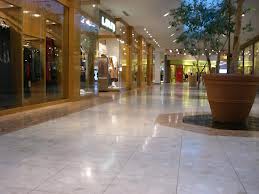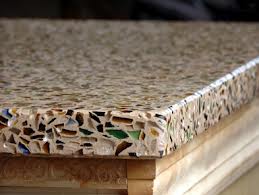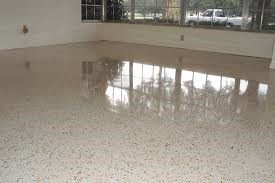Marble & Stone Restoration
---Your Complete Stone, Tile & Grout Care Professionals---
Terrazzo
Terrazzo is a composite material, poured in place or precast, which is used for floor and wall treatments. It consists of marble , quartz , granite , glass or other suitable chips, sprinkled or unsprinkled, and poured with a binder that is cementitious , chemical, or a combination of both. Terrazzo is cured and then ground and polished to a smooth surface or otherwise finished to produce a uniformly textured surface.
Production
Terrazzo artisans create walkways, floors, patios , and panels by exposing marble chips and other fine aggregates on the surface of finished concrete orepoxy -resin. Much of the preliminary work of terrazzo workers is similar to that of cement masons . Marble-chip, cementitious terrazzo requires three layers of materials. First, cement masons or terrazzo workers build a solid, level concrete foundation that is three to four inches deep. After the forms are removed from the foundation, workers add a one-inch layer of sandy concrete. Before this layer sets, terrazzo workers partially embed metal divider strips in the concrete wherever there is to be a joint or change of color in the terrazzo. For the final layer, terrazzo workers blend and place into each of the panels a fine marble chip mixture that may be color-pigmented. While the mixture is still wet, workers toss additional marble chips of various colors into each panel and roll a weighted roller (100-125 lbs.) over the entire surface.
In the 1970s, polymer -based terrazzo was introduced and is called thin-set terrazzo. Initially polyester and vinyl ester resins were used as the binder resin. Today, most of the terrazzo installed is epoxy terrazzo. The advantages of this material over cementitious terrazzo include a wider selection of colors, 1/4 inch to 3/8 inch installation thickness, lighter weight, faster installation, impermeable finish, higher strength, and less susceptibility to cracking. The disadvantage of epoxy resin based terrazzo is that it can only be used for interior, not exterior, applications. Epoxy based terrazzo will lose its color and slightly peel when used outdoors, whereas cement based terrazzo will not. In addition to marble aggregate blends, other aggregates have been used such as mother of pearl and abalone shell. Recycled aggregates include: glass, porcelain, concrete and metal. Shapes and medallions can be fabricated on site by bending divider strips or off site by water-jet cutting .
When the terrazzo is thoroughly dry (or cured in the case of thin-set terrazzo), helpers grind it with a terrazzo grinder, which is somewhat like a floor polisher , only much heavier. Slight depressions left by the grinding are filled with a matching grout material and hand-troweled for a smooth, uniform surface; it is then cleaned, polished, and sealed
Historical
Terrazzo was originally invented by Venetian construction workers as a low cost flooring material using marble chips from upscale jobs. The workers would usually set them in clay to surface the patios around their living quarters. Consisting originally of marble chips, clay, and goat milk (as the sealer), production of terrazzo became much easier after the 1920s and the introduction of electric industrial grinders and other power equipment.
Newly-set terrazzo will not look like marble unless it is wet. The goat's milk acts as a sealer and preserves the wet and marble-like look.
Terrazzo wall at the Gamla stan metro station, Stockholm .
Archaeologists use the word terrazzo to describe the floors of early neolithic buildings (PPN A and B, ca. 9,000-8,000 BC) in Western Asia, that are constructed of burnt lime and clay, colored red with ochre and polished. The embedded crushed limestone gives it a slightly mottled appearance. The use of fire to produce burnt lime, which was also used for the hafting of implements, predates the use of pottery by almost a thousand years. In the early Neolithic settlement of Cayönü in eastern Turkey ca. 90 m² of terrazzo floors have been uncovered. The floors of the PPN B settlement of Nevali Cori measure about 80 m². They are 15 cm thick, and contain about 10-15% lime.
These floors are almost impenetrable to moisture and very durable, but their construction involved a high input of energy. Gourdin and Kingery (1975) estimate that the production of any given amount of lime requires about 5 times that amount of wood. Recent experiments by Affonso and Pernicka have shown that only twice the amount is needed, but that would still amount to 4.5 metric tons of dry wood for the floors in Cayönü. Other sites with terrazzo floors include Nevali Cori , Göbekli Tepe , Jericho , and Kastros (Cyprus ).







